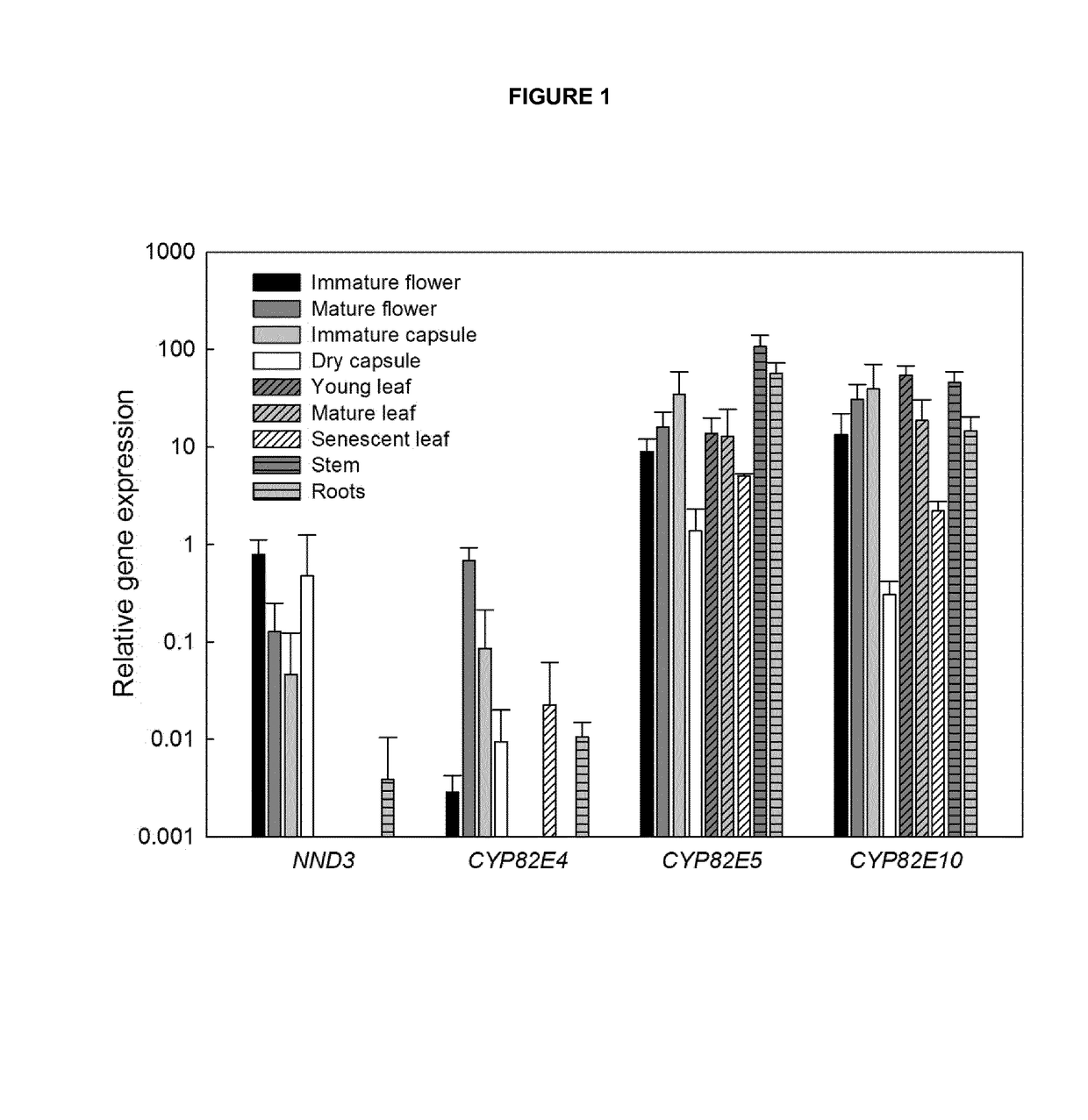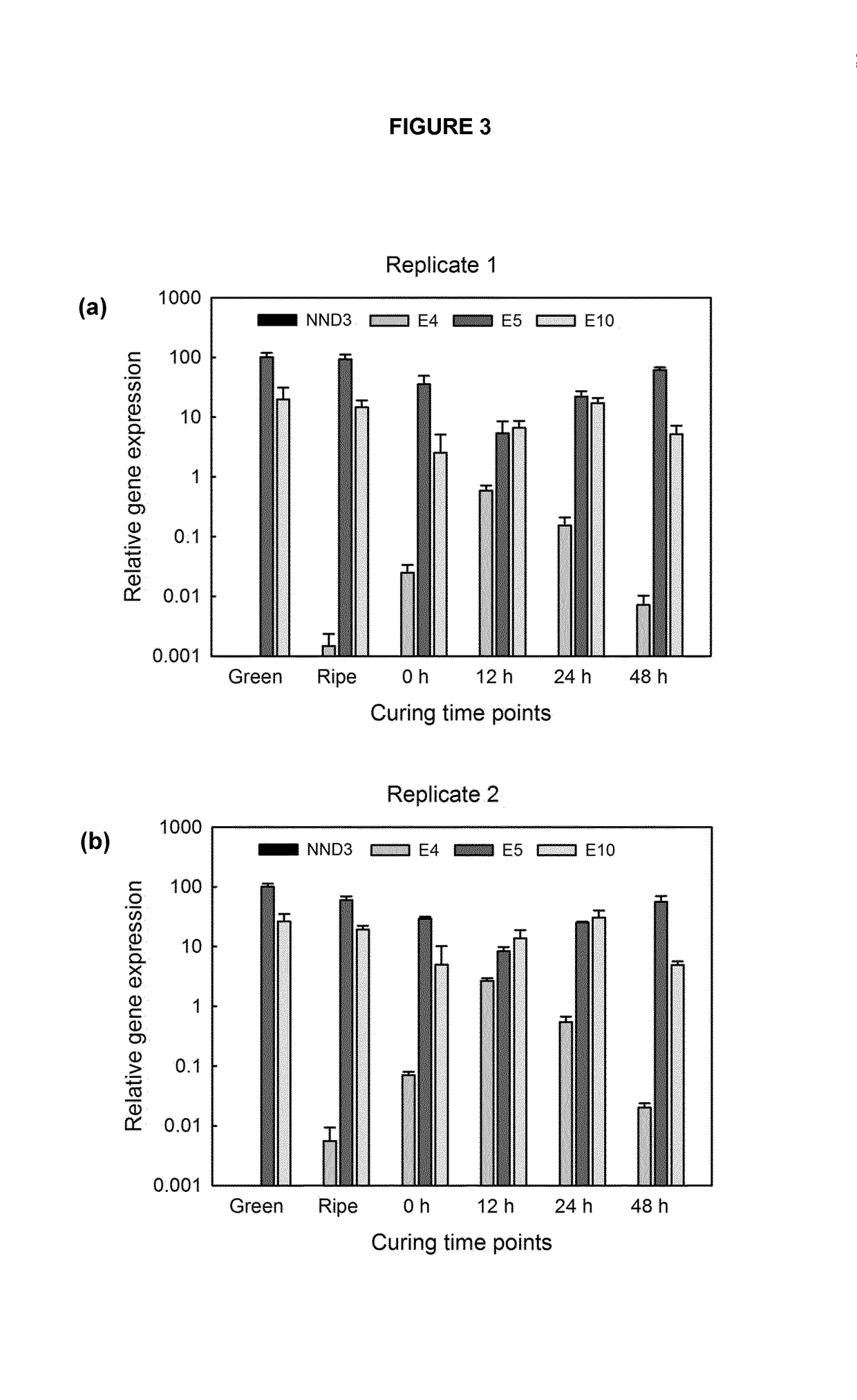Reduction of nicotine to nornicotine conversion in plants
a technology of nornicotine and nicotine, applied in the field of polynucleotide, can solve the problems of reducing affecting the efficacy and toxicity of these drugs, and adding considerable cost and time to the production of tobacco, so as to reduce the level of nornicotine, reduce the rate of nicotine conversion, and reduce the level of at least nnn
- Summary
- Abstract
- Description
- Claims
- Application Information
AI Technical Summary
Benefits of technology
Problems solved by technology
Method used
Image
Examples
example 1
Analysis of NND3 Expression Levels
[0285]To determine the function of NND3 and its role in nicotine conversion, the expression of NND3 is analyzed. For this purpose, different tissues of greenhouse grown N. tabacum var. TN90 are harvested and analysed via quantitative PCR.
[0286]RNA extraction is performed using the RNeasy Mini kit (Qiagen) according to the manufacturer's instructions. RNA samples are diluted in water to obtain 1 μg RNA in 10 μl final volume. Then DNase digestion is performed with RQ1 RNase-Free DNase (Promega). The DNase reaction is stopped using RQ1 DNase stop solution (Promega). Immediately, the reverse transcriptase (RT) reaction is performed to convert RNA into complementary DNA (cDNA). For RT reactions, M-MLV Reverse Transcriptase, RNase H Minus, Point Mutant (Promega) was used in combination with oligo(dT)15 primers.
[0287]Quantitative real-time PCR is performed using the Stratagene Mx3005P and the corresponding software. For each target, different primer pairs ...
example 2
[0290]Demonstration that NND3 Encodes for a Functional Nicotine Demethylase
[0291]Although the predicted protein sequence presents a high level of homology to known demethylases such as CYP82E4, CYP82E5 and CYP82E10, its function cannot be inferred from homology a since it has been shown in the cytochrome P450 family that a few aminoacids difference is enough to change or alleviate substrate specificity.
[0292]The function of NND3 is confirmed by overexpression in tobacco. For this purpose, an overexpression construct was designed with the NND3 coding sequence (SEQ ID NO:1) to be constitutively expressed under the control of the MMV promoter in an ultra-low converter burley plant background lacking functional CYP82E4, CYP82E5 and CYP82E10 genes.
[0293]Twenty independent transgenic lines were generated. The primary transformants (To) were transferred to soil and leaves of mature plants were analysed for NND3 expression using primers NND3_F6 and NND3_R7 (FIG. 2A) as well as for nicotine ...
example 3
[0300]Demonstration that NND3 Silencing Leads to Reduced Nicotine Conversion
[0301]A silencing construct is designed that is expressed constitutively under the control of the MMV promoter in an ultra-low converter burley plant background lacking functional CYP82E4, CYP82E5 and CYP82E10 genes. For the silencing construct, a 100 bp sequence is used in forward and reverse direction, separated by an intron sequence (SEQ ID NO: 4). Results indicate that silencing of NND3 in flowers leads to reduced nicotine conversion demonstrating that the NND3 enzyme is not only functional, but also contributes to nicotine conversion in the plant.
PUM
| Property | Measurement | Unit |
|---|---|---|
| Fraction | aaaaa | aaaaa |
| Fraction | aaaaa | aaaaa |
Abstract
Description
Claims
Application Information
 Login to View More
Login to View More - R&D
- Intellectual Property
- Life Sciences
- Materials
- Tech Scout
- Unparalleled Data Quality
- Higher Quality Content
- 60% Fewer Hallucinations
Browse by: Latest US Patents, China's latest patents, Technical Efficacy Thesaurus, Application Domain, Technology Topic, Popular Technical Reports.
© 2025 PatSnap. All rights reserved.Legal|Privacy policy|Modern Slavery Act Transparency Statement|Sitemap|About US| Contact US: help@patsnap.com



